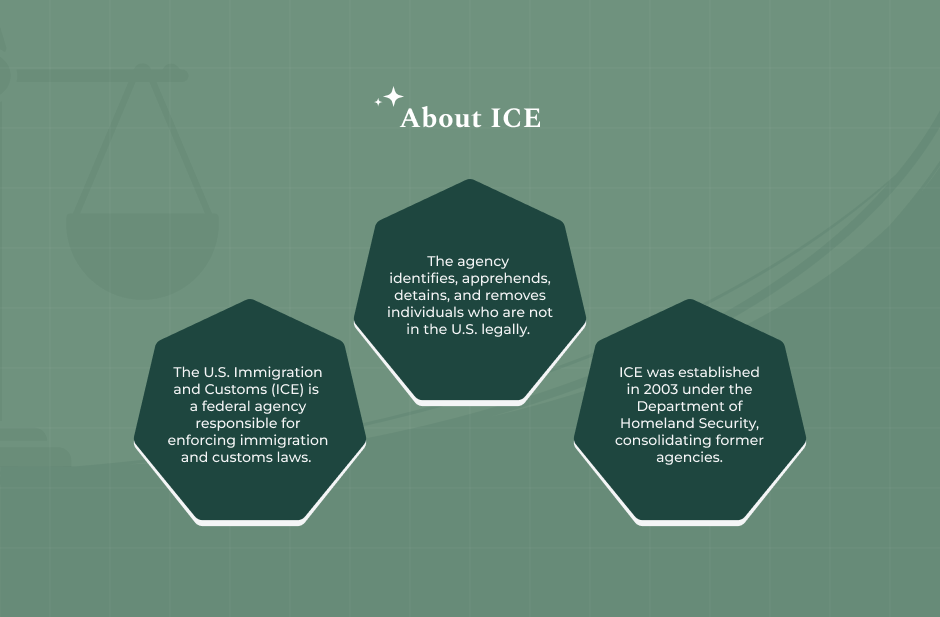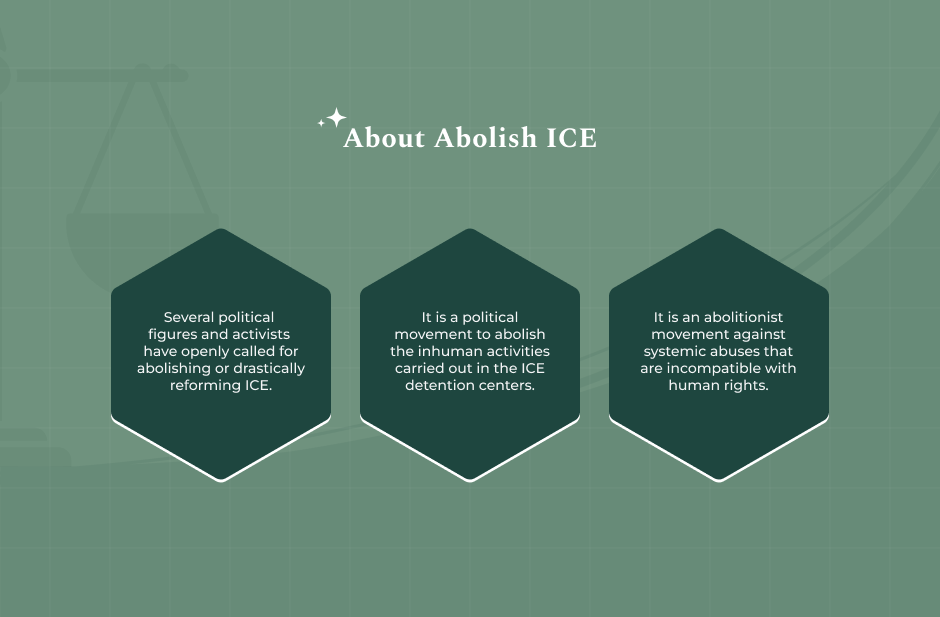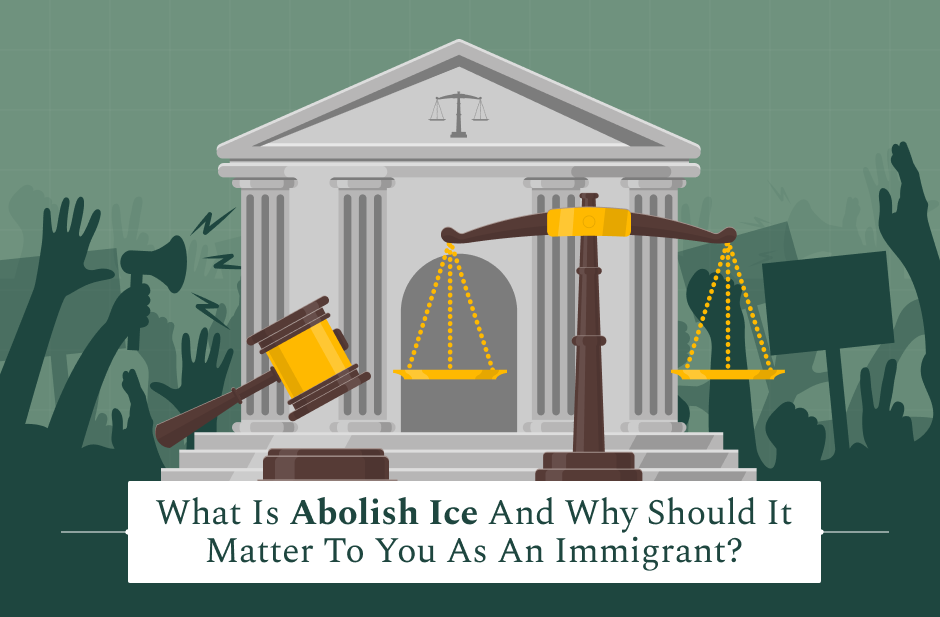U.S. Immigration and Customs Enforcement (ICE) is the federal agency responsible for enforcing immigration law within the U.S. interior. It is responsible for things like deportations, detentions, and related operations.
Created in 2003 in the aftermath of 9/11, ICE emerged from a major reorganization that aimed at bolstering national security. According to Encyclopedia Britannica, it offered a “new emphasis in the federal government on border security and the removal of undocumented immigrants.”
The “Abolish ICE” movement arises from a growing belief among activists and immigrant communities that ICE’s structure and practices are inherently harmful. This conversation matters deeply for immigrants as it shapes the environment of fear, access to rights, and the future of U.S. immigration policy.
In this article, I will talk about:
- What is ICE, and what is the background behind its creation?
- What is the “Abolish ICE” movement all about?
- The impact of the Abolish ICE movement on immigrant communities.
Additionally, I will also talk about the proposed alternatives and some of the practical ways that experts have suggested to go about this situation. So, if these are some of the things that you want to know, keep on reading this blog till the end…
What Is ICE?

ICE stands for U.S. Immigration and Customs Enforcement. It was formally established on March 1, 2003, consolidating the enforcement wings of the Immigration and Naturalization Service (INS) and the U.S. Customs Service under the Department of Homeland Security.
Prior to 9/11, the different immigration functions were organized in different departments, according to GovFacts.
The Immigration and Naturalization Service was in charge of both the administration of immigrants and their arrest—an absolute contradiction. INS in the morning would handle visa applications and in the afternoon conduct deportation raids.
The U.S. Customs Service was located in the Treasury Department and its main concerns were trade and smuggling rather than terrorism. Border Patrol was an entirely different organization and worked separately from the law enforcement inside the country.
There was very little information sharing between the agencies. The FBI, CIA, and immigration officials seldom kept each other informed about the looming threats. A number of 9/11 hijackers had illegally entered the country but had not been monitored or captured.
The Homeland Security Act of 2002 reorganized federal agencies to better coordinate national security functions in response to the 9/11 terror attacks, which ended up taking the lives of nearly 3000 Americans.
According to Encyclopedia Britannica, presently, the ICE is structured into the following units:
- Homeland Security Investigations (HSI): Handles complex transnational investigations like drug trafficking, human smuggling, and cybercrime.
- Enforcement and Removal Operations (ERO): Manages detentions and deportations of individuals deemed a threat or undocumented.
- Office of the Principal Legal Advisor (OPLA): Provides legal support in removal proceedings.
What Is The “Abolish ICE” Movement?

“Abolish ICE” is a grassroots demand to dismantle the agency entirely, not out of opposition to enforcement, but because the systemic abuses—detention, deportation, racial profiling—are viewed as incompatible with human rights and immigrant dignity.
Activists argue the agency’s foundation in criminalizing migration fosters widespread harm. However, it is important to understand that this abolitionist movement is not about establishing open borders or eliminating immigration law.
Rather, the idea is about ending a system that criminalizes migration and reallocating enforcement tasks in more humane and accountable ways. In an 2019 article NACLA mentioned that “activists have been calling for the agency’s abolition” in response to these abuses by the agency.
They mentioned that the “network of ICE-managed private detention facilities is rapidly expanding. It is behind these prison walls that ICE agents have committed their most egregious and unregulated acts of violence, including fatal medical neglect, rape, and sexual abuse of minors.”
In a Reddit thread where the author asked about a “backup plan” after abolishing ICE, one user clearly explained the demands of the “Abolish ICE” supporters:
“The ABOLISH side isn’t necessarily arguing for the US to just stop enforcing laws related to the border, but that the organization currently tasked with doing so is too flawed and corrupted to invest energy in trying to fix, so it should be abolished and a new system built up in its absence.”
Read Also: Uncovering Hidden Rules of Immigration Law
How Did Abolish ICE Movement Gain Momentum?
Back in 2014, the National Immigration Law Center (NILC) brought a suit against ICE and DHS under the Freedom of Information Act (FOIA). The NILC accessed records that indicated ICE/DHS were communicating with State Motor Vehicle Departments to obtain information for immigration enforcement.
Soon after Trump assumed office in January 2017, his administration started rolling out more stringent immigration policies that led to, among other things, the refusal of asylum for refugees and the separation of undocumented children from their families. This is something that triggered the expansion of the movement.
As per the reports by Teen Vogue, several incidents have galvanized support for the Abolish ICE movement. Some of them are:
- Family separations at the border under the “zero tolerance” policy spurred national outrage.
- Asylum seekers detained—sometimes indefinitely—fueled demands for systemic change.
- Reports of human rights abuses, including a whistleblower alleging non-consensual medical procedures at ICE facilities, held international attention.
Additionally, political figures—from Alexandria Ocasio-Cortez to Rep. Mark Pocan—have openly called for abolishing or drastically reforming ICE. Even though, TIME states that “not everyone who takes aim at ICE wants exactly the same solution.”
Social justice and prison abolition movements link to “Abolish ICE” through shared opposition to criminalization and mass detention frameworks.
Jennicet Gutierrez, who works with La Familia, told NACLA that “abolishing ICE is absolutely about shutting down detention centers, ending deportations, and defunding and dismantling the agency…we won’t stand by anymore while our people are put in cages and punished because of their gender identity or sexual orientation.”
ICE Alternatives: What Could Replace The Agency?
In an interview with GQ, Cecilia Muñoz, the former domestic policy director for Barack Obama, stated how they had “ramped up alternatives to detention to make sure that people could be released into the community, but [they] could still have confidence that they would show up at their removal hearing.”
“We also initiated the community-based alternative to detention, where we essentially worked with faith-based groups who agreed to connect with folks that were released into the community and ensure that they would show up at their hearings. Those programs, though small, had very high success rates at making sure that people stayed in the process,” she added.
Some of the possible solutions that experts have proposed according to The Washington Post, include the following:
- Developing community-centered programs that focus on social services, integration, and legal protections.
- Restoring enforcement tasks to USCIS or similar civil authorities, decoupling immigration enforcement from criminal justice.
- Redirecting budgets from ICE to local resources that prioritize safety without criminalizing undocumented communities.
Some argue reforming ICE—improving transparency, accountability—is a pragmatic step forward. Yet, according to NACLA, activists counter that ICE’s foundational design cannot truly be fixed, calling it inextricably tied to criminalization and profit-driven detention.
Read Also: E-2 Visa: Investor Visa USA Guide, Requirements, And More
Your Legal Guide: Why Should Abolish ICE Movement Matter to You As An Immigrant?
The presence of ICE fosters fear—raids and arrests can happen without warning, leading to deportations of individuals including legal residents.
Families get torn apart; communities live in trauma. For example, agricultural regions like Oxnard, CA experienced massive labor loss and economic fallout in 2025 after ICE raids disrupted harvests, as reported by Cornell University.
Many immigrants face difficulties accessing asylum and due process. ICE’s operations often involve racial profiling and over-policing, contributing to injustice
Community life is altered: children skip school due to fear, workplaces go empty during raids, and mixed-status families endure constant anxiety.















